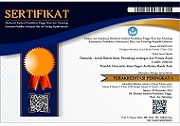CITATIONS
PROOF OF THE CRIME OF MURDER REGARDLESS OF THE USE OF FORENSIC AUTOPSY EVIDENCE (Kendari District Court Study)
Abstract
In essence, evidence in criminal cases is an effort to provide evidence through tools that can prove a case and its allegations, one of which is forensic autopsy evidence which is used as evidence. In fact, forensic autopsy evidence is very important in criminal homicide cases because it can confirm a person's death carried out by a forensic autopsy expert and speed up the court process. The aim is to prove the KUHAP evidentiary system through forensic evidence, and determine the value of forensic evidence in murder, and use it as expert testimony, this is also used as a basis for the judge's decision against the defendant. The research carried out is empirical legal research using an empirical approach from secondary data by managing primary, secondary and tertiary legal materials. Based on the research results, first we have to know that every country definitely has laws or regulations that apply in each country. As in murder cases, if witness statements are not always correct, judges really need forensic autopsy evidence as expert testimony, and it is rare to find witnesses who directly witnessed the crime of murder, and this becomes an obstacle for judges. Then in murder cases, many families do not want to have a forensic autopsy done. The meaning of a forensic autopsy is to find the true case and look for the causes that caused the person's death. Then, for clues and truth, a forensic autopsy must be carried out to achieve justice.
Keywords
Evidence, Crime of Murder, Evidence, Forex Autopsy
Full Text:
PDFReferences
Buku-Buku
Amri Amir, 2011, Autopsi Medikolegal, Medan, Percetakan Ramadhan.
Andi Hamzah, 2002, Hukum Acara Pidana Indonesia, Jakarta, Sinar Grafika.
Darwan Prinst, 1998, Hukum Acara Pidana Dalam Praktik, Jakarta, Djambatan.
Gerry Muhamad Rizki, 2008, KUHP dan KUHAP, Jakarta, Permata Press.
Ismu Gunadi, 2011, Cepat dan Mudah Memahami Hukup Pidana Jilid 2, Jakarta, Prestasi Pustaka Publisher.
Made Agus Gelgel Wirasuta, 2008, Analisis Toksikologi Forensik, Bali, Farmasi Universitas Udayana.
Moelijatno, 1987, Asas-Asas Hukum Pidana, Jakarta, Bina Aksara.
Sahrawardi, 2015, Etika Profesi Hukum, Jakarta, Sinar Grafika.
Soeparmono, 2016, Keterangan Ahli dan Visum Et Repertum Dalam Aspek Hukum Acara Pidana, Bandung, Mandar Maju.
Surjit Singh, 2011, Ilmu Kedokteran Forensik, Jakarta, Sinar Grafika.
Teguh Prasetio, 2012, Hukum Pidana, Jakarta, PT Raja Grafindo Persada.
Skripsi
Shellanika Ari Astuti, 2014, Skripsi: Kekuatan Pembuktian Keterangan Ahli Forensik Dalam Tindak Pidana Pembunuhan Bayi Oleh Ibunya (Tinjauan Yuridis Putusan No. 147/Pid.B/2013/PN.Pwt), Purwokerto, Fakultas Hukum Universitas Jendral Soedirman.
Khoirul Rizal, 2011, Skripsi: Kekuatan Pembuktian Otopsi Forensik Dalam Kasus Pembunuhan (Studi Komparatif Hukum Acara Pidana Islam dan KUHP), Surabaya, Fkultas Syariah UIN Sunan Ampel.
Undang-Undang
Kitab Undang-Undang Hukum Pidana (KUHP).
Kitab Undang-Undang Hukum Acara Pidana (KUHAP).
Undang-Undang Nomor 44 Tahun 2009 Tentang Kesehatan.
DOI: http://dx.doi.org/10.22373/dusturiyah.v14i1.23289
Refbacks
- There are currently no refbacks.
Copyright (c) 2024 Irmansah Irmansah, Hariman Satria, Gamlan Dagani
Indexed by:
Tools:
All papers published in Dusturiyah: Jurnal Hukum Islam, Perundang-undangan dan Pranata Sosial are licensed under a Creative Commons Attribution-ShareAlike 4.0 International License. |
Office address: Fakultas Syariah dan Hukum Universitas Islam Negeri Ar-Raniry. Jl. Ar-Raniry, Kopelma Darussalam, Syiah Kuala, Banda Aceh, Aceh, Indonesia 23111. Email: jurnal.dusturiyah@ar-raniry.ac.id
situs toto slot gacor slot gacor situs toto















